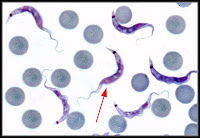 Phylum Sporozoans are nonmotile, unicellular protists that are commonly parasitic on vertebrate animals. The microorganisms invade red blood cells where they multiply, eventually escaping from the ruptured cells. The disease is characterized by spells of fever and chills, associated with the simultaneous rupture of red blood cells. Malaria is one of the most widespread diseases throughout tropical regions of the world, and it is transmitted through the bite of the female Anopheles mosquito.
Phylum Sporozoans are nonmotile, unicellular protists that are commonly parasitic on vertebrate animals. The microorganisms invade red blood cells where they multiply, eventually escaping from the ruptured cells. The disease is characterized by spells of fever and chills, associated with the simultaneous rupture of red blood cells. Malaria is one of the most widespread diseases throughout tropical regions of the world, and it is transmitted through the bite of the female Anopheles mosquito. Phylum Ciliophora are fringed with hairlike cilia which propel them through the water. Conjugation is a form of sexual reproduction in which the individual cells fuse together and swap nuclear DNA in the form of small micronuclei. It involves the division and fusion of micronuclei from opposite paramecia. After conjugation, each paramecium continues on its way, genetically altered from its brief encounter because of different chromosomal combinations. The genetically altered paramecia continue to produce clones of themselves by asexual cell division, a process known as fission.
Phylum Rhizopoda includes a large group of protists that move by means of pseudopods. Most Rhizopodians use their pseudopods to capture prey and also for locomotion. Rhizopods are heterotrophic, feeding on a wide range of bacteria, algae and other protists. Some Rhizopodians are important parasites. Entamoeba histolytica causes amebic dysentary and another Entamoeba is a common symbiont in the human mouth where it feeds on bacteria and human macrophages.
Phylum Zoomastigophora are named for the flagella that they use to move themselves. They engulf and consume their prey by phagocytosis. Most zooflagellates live alone, but some species form colonies of cells. They are found in the gut of termites, and are used to digest the cellulose in wood. Some Zooflagellates are not symbiotic, but parasitic.
http://waynesword.palomar.edu/trnov01b.htm
http://www.ncbi.nlm.nih.gov/pmc/articles/PMC372943/
http://library.thinkquest.org/27819/ch7_8.shtml
http://staff.jccc.net/pdecell/protista/rhizopoda.html
Images from Google



No comments:
Post a Comment